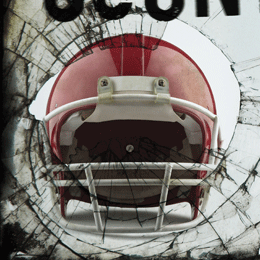
Thousands of former NFL players and one Haddonfield attorney are determined to change the face of football in America as we know it.
Despite retiring from the National Football League after the 2001 season, Eric Allen still has fond memories of being chosen by the Philadelphia Eagles in the second round of the 1988 draft. Suddenly, he’s back at his first pro training camp working alongside Andre Waters, his first roommate in the NFL.
Both defensive backs became stars under the famed Buddy Ryan—Allen a shut-down cornerback and Waters a feared safety nicknamed “Dirty Waters” for the ferocious hits he’d deliver to opponents. Sadly, Allen can no longer pick up the phone to relive these glory days with his old friend. Waters committed suicide in 2006—many believe because of depression brought on by those repeated vicious hits to the head during his career.
Waters’ death sent shockwaves around the Eagles community, but it also opened some of his former teammates’ eyes to an ongoing issue they allege has been a dirty secret swept under the rug while the NFL capitalizes on being a larger-than-life corporation: concussions and player safety.
Allen’s connection to Waters may be the biggest reason why he has joined more than 4,000 retired players in a multi-litigation lawsuit against the NFL, charging the league knowingly concealed information about the extent of life-changing head injuries suffered while on the field.
“You play the game for so long and give so much of yourself,” Allen says. “To see a guy like Andre Waters [commit suicide], I think that’s the most important reason for me [to get involved].”
The lawsuit plantiffs include Hall of Famers like Eric Dickerson, Tony Dorsett and Tommy McDonald. Former Eagles greats like Seth Joyner and Jeremiah Trotter. Super Bowl-winning quarterbacks like Mark Rypien and Jeff Hostetler. Well-known broadcasters like Brian Baldinger, familiar names like John Brodie and forgotten names like Britt Hager.
They played during different eras and all had unique experiences in their football careers, but now they find themselves united as NFL alumni on a mission, a mission that includes multi-billion dollar litigation that would change America’s favorite sport.
In a master lawsuit filed last summer, the players accused the league of intentional misrepresentation of the facts about head injuries, negligence and fraud. They are seeking medical monitoring and financial compensation for the long-term, chronic injuries associated with repeated blows to the head.
“It’s to help retired players, the guys who gave so much to the game,” says Allen, a former All-Pro with the Eagles and a current NFL analyst for ESPN. “Once they are finished, we need to make sure they are taken care of. I think it starts there and then it’s a tidal wave and it goes down to college, it goes down to high school and eventually it goes down to where my kids are now. I have an 8-year-old who’s in his first year playing tackle football, so we have to make those kids aware [of the dangers of football] also.
“For me, [this case] is for all four levels. And I feel like, if you get to the league, they need to take care of a guy forever.”
And it’s not just the primetime tilts on Sundays that has Allen concerned. “Someone needs to be big enough to step up and talk about how those little taps we receive in practice are just as bad as the big ones we see on Sunday,” he says.
McDonald, a Hall of Fame wide receiver who played on the Eagles’ last championship team in 1960, may be further removed from the game than Allen, but his feelings are just as strong. “I’m worried, and I think a lot of players are worried about the future,” adds McDonald. “The NFL knows that families come first, and the NFL knows it didn’t do enough. … They must protect the retired players given what we know about concussions. The league should allow all retired players, whether they have symptoms or not, to be monitored and treated.”
The national debate over head injuries, particularly in a violent yet wildly popular sport like football, has been waged for several years now, and the NFL has clearly responded. Standardized sideline testing has been implemented to diagnose concussions during games and practices, and the league has donated its vast financial resources to concussion research.
The league also contends it has always stressed player safety and should not be held responsible for any effects players are facing from head injuries. “The NFL has long made player safety a priority and continues to do so,” says league spokesman Brian McCarthy. “Any allegation that the NFL intentionally sought to mislead players has no merit. It stands in contrast to the league’s actions to better protect players and advance the science and medical understanding of the management and treatment of concussions.”
The NFL doesn’t believe the case belongs in court, insisting the issues fall under the collective bargaining agreement with the players’ union and should therefore be resolved through arbitration. The league is looking to get the multi-litigation complaint dismissed from United States District Court in the Eastern District of Pennsylvania.
Judge Anita B. Brody was scheduled to make her ruling in Philadelphia federal court on the dismissal in July, but instead ordered the attorneys from both sides into mediation. She appointed former federal Judge Layn Phillips as mediator, and if a settlement cannot be reached by Sept. 3, she is expected to rule on the NFL’s motion to dismiss. In the meantime, she has asked both sides not to discuss the mediation.
“Mediations are always very, very helpful,” says Haddonfield attorney Craig Mitnick, who represents more than 1,000 retired players in the case along with Philadelphia lawyer Gene Locks. “The judge has ordered both sides to mediate and both sides have agreed to mediate. Where that goes, I have no idea, and I can’t make any further comment beyond that. I’m a positive person in general, so I’m positive about the mediation. I think it’s a major step in the right direction.”
Mitnick first got involved in the case about 18 months ago when he was approached by Locks. He used his friendships with several former Eagles—including fullback Kevin Turner, who is now battling ALS and is one of the plaintiffs—to land a number of clients, and traveled around the country talking to retired players. The more players he talked to, the more he believed that their everyday lives are severely impacted by the hits they took during their playing days.
“It’s not a game by any means,” Mitnick says. “If the average fan understood the implications that these head impacts have on the players and their lives, they would feel a lot differently. When I first got involved and I started to tell other lawyers in the area, they thought it was a crock—just another ploy to get money. But public sentiment here and around the whole country has done a 360. People are favoring the players, but they don’t want the game of football to go away.
“That’s what I thought about when I got involved. ‘My God, lawyers screw things up all the time. Are lawyers gonna make the game of football go away, and am I gonna be one of those lawyers?’ The answer is no, football is not going to go away. But the players are going to be protected more, the league is doing what they should do and they need to do a lot more.”
One of Mitnick’s most high-profile clients was Alex Karras, a Pro Bowl defensive lineman with the Lions who went on to star in such movies as Blazing Saddles as well as the television show Webster. Karras, who suffered from dementia late in life and blamed his NFL career for the health issues, died last October at 77. Susan Clark, his wife and co-star in Webster, continues to be represented by Mitnick in the case.
“[Karras] was charismatic; he was the huge guy in the room,” Mitnick says. “But at the end, he couldn’t do anything that he enjoyed. His wife Susan spent a lot of time with him outside, but he couldn’t drive or anything. It was severe dementia. Some of these guys can’t remember who they are; 80 percent of them are divorced. There are real stories behind these names and faces.”
Byron Evans is a much younger retired player experiencing issues he believes might be related to his NFL career. A linebacker on the dominant Eagles defenses of the late ’80s and early ’90s, the 49-year-old now lives in Arizona.
“Not only does your body start to deteriorate, but your mental aspect deteriorates,” Evans says. “Many times you go into a room and you kind of forget what you came in for. Something like that shouldn’t be happening at my age.
“[We need] a long-term solution, something that really shores up what effect concussions have on the game.”
The concussion issue especially hits home for Evans, Allen and other former Eagles because of the case of Waters. The safety is one of several retired players—a list that includes Junior Seau and Dave Duerson—who committed suicide after his career.
All three of those players were found to have chronic traumatic encephalopathy, or CTE, a condition thought to be triggered by repetitive brain trauma. Although some researchers stress there is no direct evidence linking CTE to suicide, it remains a concern of former players.
“[Andre Waters], that could have been me,” says former Eagles running back Keith Byars. “I was never diagnosed with a concussion, [but I had] at least one or two a year, and I played 13 years.”
“I remember the autopsy of the late, great Andre Waters, and all the depression that he went through,” Evans says. “So I’m here to voice my opinion.”
One of the major questions in the case is how much the NFL knew about the effects of head injuries and whether it acted correctly in its role as guardian for the players. The league stands by its decisions, but if the case goes to trial and Judge Brody orders discovery, exactly what the NFL knew and when could come to light.
“I think that the league damn well knew the effects on these guys and covered it up, no doubt about it,” Mitnick says. “They skewed data, they skewed reports, they were all about money and they glorified violence through NFL Films.”
The players, however, could also be impacted if no settlement is reached, as the case could drag on for years. Those already in need of treatment could deteriorate quickly, and more could develop symptoms. Mitnick has seen firsthand the mood swings, anxiety and depression many of his clients face, and the impact their behavior can have on their wives and children. That’s why, he says, he is so passionate about the case.
“One of my closest friends at one point was Kevin Turner,” Mitnick says. “I used to snowboard with him in the offseason. Kevin has ALS now. He just can’t do anything by himself, and he’s so proud that he tries to do everything. He says that by the time this case is over, he won’t be alive. And he has little kids. It takes an emotional toll.
“One of the main motivating factors for filing this suit is to force the NFL to set up a medical monitoring program, so that every retired player has the ability, if they choose, to go to a doctor and get checked out. … And once they are diagnosed, they will be able to get treatment. The players who are truly injured will hopefully get money that will enable them to get medical treatment and support their wives and children and make their lives at least livable. Because these guys are not all who the fans think they are. They’re not these strong guys that have just gotten older and are out playing golf and living the easy life. Many of them have really, really hard lives because of the condition they’re in.”
Mitnick and Locks are working with several other attorneys in this high-profile lawsuit, including Tom Girardi, the class-action lawyer famous for the case that inspired the film Erin Brockovich.
“It’s satisfying, because I think that we’re actually changing something that’s part of American history and part of the culture. We’re trying to protect the game and the players without making it go away. It’s a very fine line. I think if both sides recognize that there were risks and mistakes on both sides, we can come to a resolution,” says Mitnick.
Like his former teammates and peers he competed against, Allen is eager for such an ending. “The game will always be the top game in America, it is the greatest entertainment that we can get here. We just need to make sure that those entertainers, after they’ve finished playing and are out of the spotlight, that they are taken care of after the curtains are down and the lights are off.”
Published (and copyrighted) in South Jersey Magazine, Volume 10, Issue 5 (August, 2013).
For more info on South Jersey Magazine, click here.
To subscribe to South Jersey Magazine, click here.
To advertise in South Jersey Magazine, click here.












